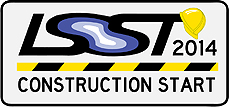AURA awarded support by the National Science Foundation to begin constructing LSST
 |
| The Large Synoptic Survey Telescope will image the sky for 10 years, sharpening our understanding of the universe. Image: LSST |
Editor's note: The official startup of the $473 million Large Synoptic Survey Telescope project was announced on Monday (see press release below). The initiation of LSST construction represents the next step in a journey to map the cosmos in order to understand fundamental physics. The National Science Foundation is the project's lead federal agency and supports the central project office, the telescope, site, data management and education and public outreach elements of the project. The Department of Energy provides the camera and related instrumentation.
Fermilab has played major roles in the construction and operation of two predecessor survey projects, the Sloan Digital Sky Survey and the Dark Energy Survey, and expects to play key roles in the LSST project as well. Fermilab astrophysicist Josh Frieman serves on the LSST corporate executive board, and Fermilab scientist Scott Dodelson coordinates Fermilab's role in the science collaboration. From software development to operations to scientific analysis, Fermilab has expertise that will be valuable to the LSST project. The laboratory hosted a joint DES/LSST workshop in March. LSST will begin full science operations in 2022. DOE's contributions are managed by SLAC National Accelerator Laboratory.
The National Science Foundation (NSF) agreed on Friday to support the Association of Universities for Research in Astronomy (AURA) to manage the construction of the Large Synoptic Survey Telescope (LSST). This marks the official federal start of the LSST project, the top-ranked major ground-based facility recommended by the National Research Council's Astronomy and Astrophysics decadal survey committee in its 2010 report, New Worlds, New Horizons. It is being carried out as an NSF and Department of Energy (DOE) partnership, with NSF responsible for the telescope and site, education and outreach, and the data management system, and DOE providing the camera and related instrumentation. Both agencies expect to support post-construction operation of the observatory.
The NSF construction budget for LSST is not to exceed $473M. The DOE Camera fabrication budget will be baselined later this year, but is estimated to be $165M. Operations costs will be around $40M per year for the ten-year survey. With the approved start occurring now, LSST will see first light in 2019 and begin full science operations in 2022. Today's action culminates over ten years of developing, planning and reviewing of the LSST concept.
LSST Project Manager, Victor Krabbendam, was delighted to receive the welcome news from NSF: "This agreement is a tribute to the hard work of an exceptional team of highly skilled individuals, many of whom have dedicated more than a decade to bringing LSST to this point. After a rigorous design and development phase, the project team is ready to get down and dirty and actually build this amazing facility."
LSST Director, Steven Kahn of Stanford University, commented on the unique contributions LSST will make to astronomy and fundamental physics: "The broad range of science enabled by the LSST survey will change our understanding of the dynamic Universe on timescales ranging from its earliest moments after the Big Bang to the motions of asteroids in the solar system today. The open nature of our data products means that the public will have the opportunity to share in this exciting adventure along with the scientific community. The most exciting discoveries will probably be those we haven't yet even envisioned!"
Read more
|